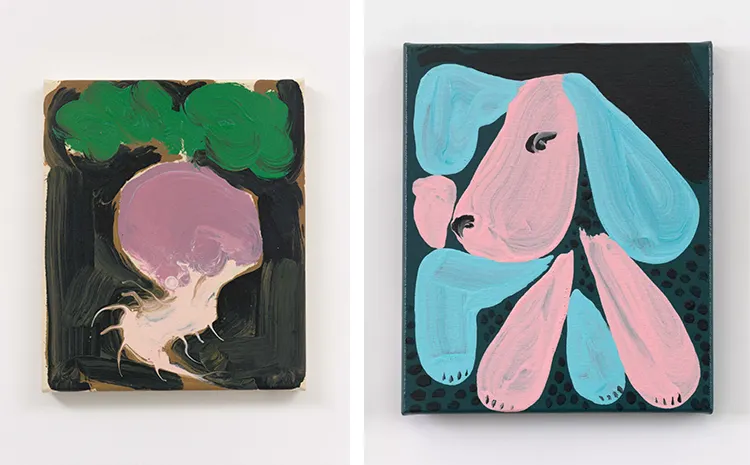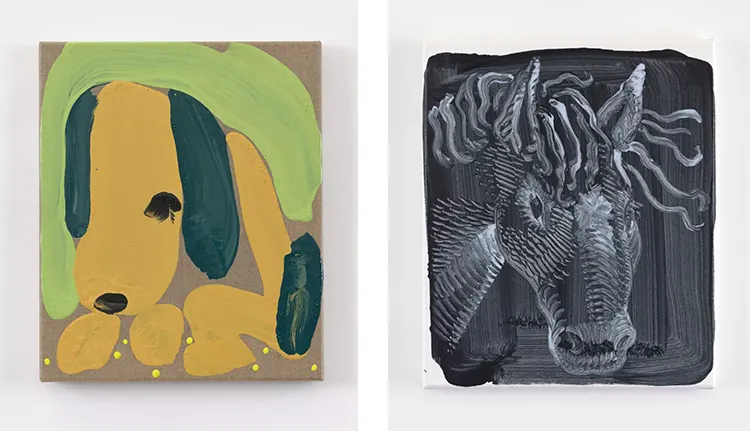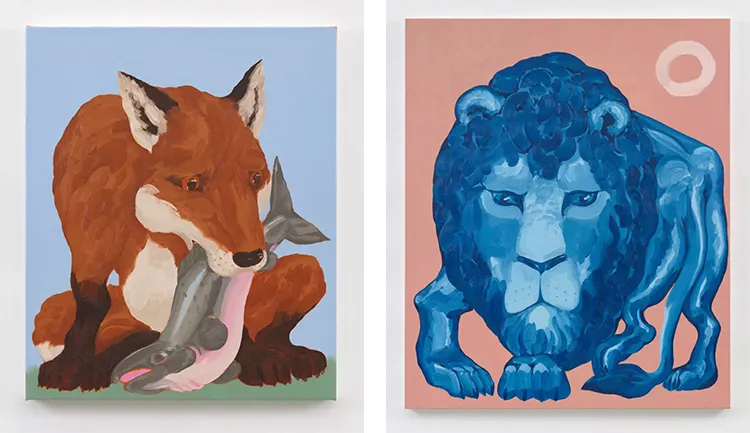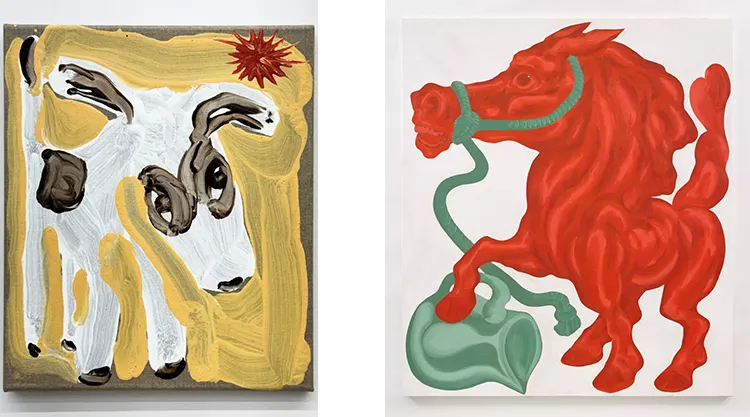A Visual Language of Feeling and Form
David Surman’s work occupies a unique space in contemporary painting, blending figurative representation with an expressive, gestural approach. For the past eight years, his focus has been on depicting animals—not merely as subjects, but as vessels for exploring human emotion, cultural projection, and the fluid boundaries between artistic styles. His paintings often hover between control and chaos, where a single brushstroke can feel both deliberate and on the verge of collapse. This dynamic approach reflects his belief that painting is a living, evolving language rather than a fixed tradition.
A defining aspect of Surman’s practice is his use of pathetic fallacy—the attribution of human emotions to the natural world. His animal figures exude a mix of sincerity and irony, tenderness and humor, creating a complex emotional landscape that resists easy categorization. By incorporating cartoon-like forms alongside traditional painterly gestures, he directly challenges distinctions between so-called “high” and “low” art, questioning the hierarchies that have historically shaped artistic taste. His work invites viewers to consider not just the animals he portrays, but also the way we, as humans, impose meaning upon them.
Surman’s paintings do more than depict—they engage. His figures often meet the viewer’s gaze in ways that can feel affectionate, accusatory, or eerily knowing. This sense of direct engagement is central to his work, encouraging a dialogue between the painting and the observer. Through his nuanced use of paint—sometimes thick and expressive, sometimes thin and barely there—he creates surfaces that echo the tension between structure and abandon, mirroring the complex, often contradictory ways we relate to the natural world.

David Surman: From Filmmaking to the Stillness of Paint
Before establishing himself as a painter, Surman pursued a career in animation and experimental filmmaking. His early studies at Newport Film School in the early 2000s placed him in an environment where moving images were not just about storytelling, but also about sensation, rhythm, and composition. Influenced by avant-garde filmmakers such as Chris Marker and Robert Breer, he was drawn to the way editing and movement could reshape perception. These early explorations laid the groundwork for his later approach to painting, instilling in him an acute awareness of visual impact and the ways in which an image can guide the eye.
Despite his deep engagement with film, Surman found himself increasingly drawn to the physicality of painting. Unlike moving images, which are transient and constantly shifting, paintings exist in a state of stillness, confronting the viewer with their presence. This contrast fascinated him, and by 2014, he had returned fully to painting. Yet, his background in film remains evident in his work—his compositions often carry a sense of movement, tension, and immediacy, as if capturing a fleeting moment in time.
One of the key lessons Surman carried over from filmmaking was the ability to construct images that deliver an immediate impact. His paintings often feel like visual events, where the first encounter is arresting, but further observation reveals layers of meaning. However, at its essence, his practice is rooted in mark-making—a process he has been engaged with since childhood. The act of painting, for him, is not just about representation but about the energy and physicality of the medium itself.

The Influence of Landscape and Upbringing
Surman’s connection to animals and nature can be traced back to his upbringing in rural Britain. Born in a coastal village in southwest England, he spent his formative years surrounded by the raw beauty of the countryside. Later, his family moved to the northwest of Scotland, a place defined by its vast, untamed landscapes and sense of isolation. These early experiences left a deep impression on him, shaping both his artistic sensibilities and his thematic interests.
A major influence in his development was his mother, a skilled draughtsperson and sculptor who, despite never pursuing art professionally, instilled in him an appreciation for form and observation. Watching her sketch animals, he absorbed an intuitive understanding of line and gesture. Another pivotal figure was Rob Fairley, an experimental painter living in Scotland, who introduced him to a broad spectrum of artistic traditions, from the modernist works of Picasso and Matisse to the radical approaches of Viennese Actionism. These early exposures helped him see art not just as a means of aesthetic creation but as a way of engaging with the world intellectually and emotionally.
His dual experience of rural isolation and urban dynamism continues to shape his work. As a young gay man growing up in a remote environment, he felt a deep yearning for the energy and openness of city life. Now based in London, he often finds himself nostalgic for the quiet and expansiveness of the countryside. This push and pull between the natural world and metropolitan existence permeates his paintings, creating an underlying tension that mirrors his own lived experiences.

David Surman: Painting as an Act of Instinct and Inquiry
Surman’s painting process is characterized by immediacy and instinct. Most of his works are completed in a single session, a practice that demands both intense concentration and decisiveness. He begins by carefully observing the blank canvas for extended periods, allowing ideas to form before making a mark. Using charcoal, he sketches out the foundational structure of the image, ensuring the composition is balanced before applying paint. Once he begins painting, the process is rapid and fluid, driven by an attempt to capture a precise emotional and formal moment.
This approach aligns with his interest in gestural mark-making, where each stroke carries a sense of urgency and intention. His paintings often appear raw, with visible drips, smudges, and unfinished edges that embrace imperfection. This unfinished quality is deliberate, preserving the energy of the moment and preventing the work from becoming overly polished or static. His use of color is equally deliberate, chosen to evoke specific emotional tones—whether warmth, melancholy, or unease.
Surman also engages with the aesthetics of cuteness, a theme often dismissed in fine art for its associations with commercialism and sentimentality. He sees cuteness as a powerful visual tool—one that can attract and disarm viewers while simultaneously carrying deeper, more unsettling undertones. His animal figures may appear playful and endearing at first glance, but their expressions often hint at something more ambiguous, even troubled. Through this juxtaposition, he challenges traditional notions of artistic seriousness, questioning why certain visual languages are deemed worthy of intellectual engagement while others are relegated to the periphery.
As he prepares for his upcoming solo exhibition, Divas Everywhere, at Rebecca Hossack Gallery in March 2025, Surman is returning to oil paint after several years of working primarily with acrylics. This shift in medium reflects his ongoing commitment to exploring the material possibilities of painting, continually pushing the boundaries between gesture, structure, and emotional resonance. His work remains an evolving conversation—between past and present influences, between artist and viewer, and between the fleeting nature of emotion and the enduring presence of paint.

The post David Surman: The Art of Feeling in Motion and Stillness appeared first on AATONAU.
+ There are no comments
Add yours